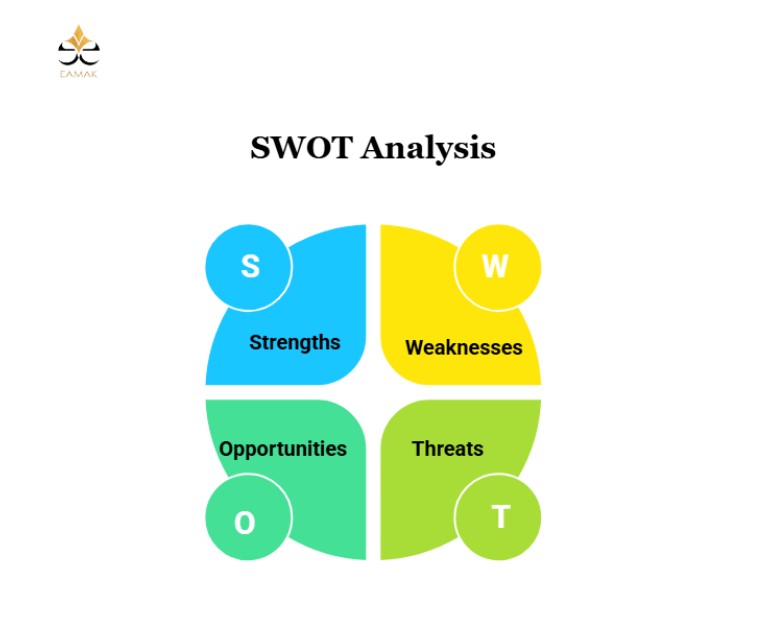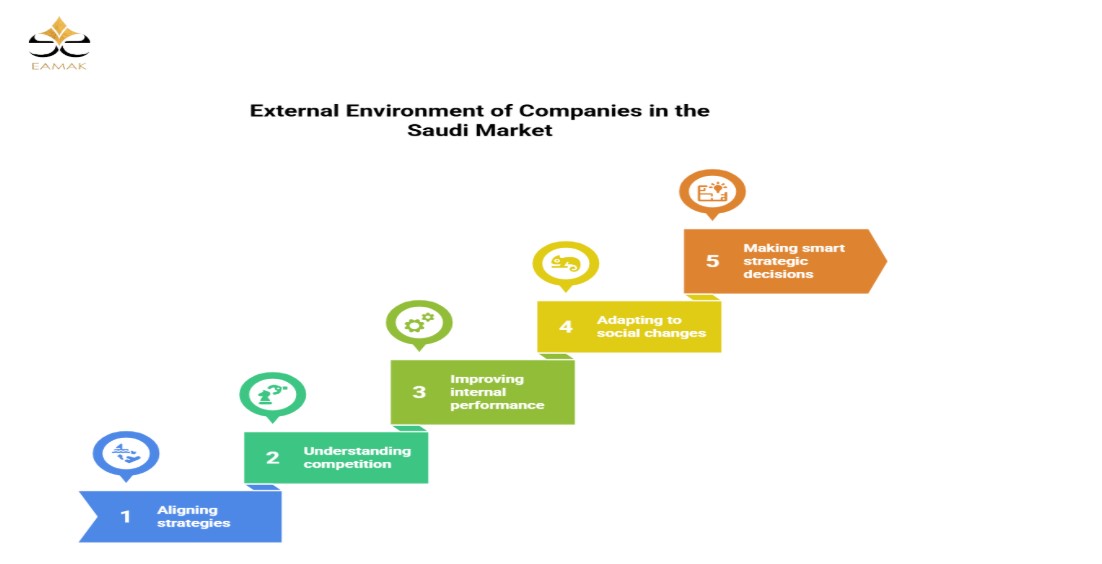The Importance of Analysis of the internal and external environment of companies
- Posted by:
- Category: Uncategorized

In a fast-changing and highly competitive world, analysis of the internal and external environment of companies has become a vital strategic necessity. Understanding what happens inside the organization and what affects it from the outside forms the foundation for making successful decisions and building effective plans.
In this article, we explore how this type of analysis can make a real difference in the future of companies and organizations.
Internal Environment Analysis
Internal environment analysis refers to the assessment of a company’s strengths and weaknesses. It includes the internal factors that affect its performance, such as
- Financial resources: Including assets, cash flow, and debts.
- Human resources: Including the company’s organizational structure, and the skills and experience of employees.
- Marketing: Including brand reputation, customer satisfaction, and market share.
- Operations: Including adaptability to change, efficiency, and innovation.
- Technology: Including current systems and the ability to adopt new technologies.
The importance of internal environment analysis lies in its ability to provide a clear view of the company’s available capabilities and resources. It also helps in making better decisions, setting suitable strategies, and identifying strengths and weaknesses.
External Environment Analysis
External environment analysis is the process of studying external factors that may affect the performance and success of a company. It includes four main areas:
- Political factors: Understanding government laws, regulations, and political changes in countries where the company operates.
- Social and cultural factors: Understanding the values and social culture of the communities the company serves and how they influence customer preferences and behavior.
- Economic factors: Studying general economic conditions such as inflation, economic growth rates, and price fluctuations, and how these affect supply, demand, and production costs.
- Technological factors: Studying innovations and advanced technologies in the industry and how they can be used to improve products and services.
External environment analysis is essential for any company or organization that wants to achieve long-term success in a constantly changing business world.
Strategic Analysis Tools
There are several tools used in analysis of the internal and external environment of companies, including the following:
SWOT Analysis

SWOT analysis is one of the most common strategic tools. It helps evaluate both internal and external environments of companies.
SWOT stands for
- Strengths: What the company excels in and can build upon.
- Weaknesses: Areas that need improvement or fixing.
- Opportunities: Market trends or openings that can be taken advantage of.
- Threats: External challenges or risks that could negatively impact the company.
PESTEL Analysis
PESTEL analysis is one of the strategic analysis tools used to evaluate the external environment of a company. It enables organizations to understand how different external elements can affect their operations, both in the present and in the future. As a strategic tool, it supports the identification of potential opportunities and challenges that businesses may encounter.
PESTEL refers to the six external factors that can influence business activities, which are
- Political factors (P).
- Economic factors (E).
- Social factors (S).
- Technological factors (T).
- Environmental factors (E).
- Legal factors (L).
It supports companies in identifying possible opportunities and challenges in the market.
Integration of Internal and External Environment Analysis
Integration of internal and external environment analysis is a key pillar of successful strategic planning. It’s not only about understanding internal strengths and weaknesses but also about recognizing external opportunities and threats. This helps in creating a well-rounded and effective strategy.
According to OnStrategy, this type of analysis builds a clear picture of a company’s current situation and supports smarter strategic decisions.
It also helps companies achieve strategic alignment, which means matching internal capabilities with external opportunities. This alignment allows companies to maximize competitive advantages and reduce risks.
So, integration of internal and external environment analysis is not just an analytical step but a strategic process that strengthens a company’s ability to adapt and succeed.
Importance of Analysis of the Internal and External Environment of Companies in the Saudi Market
 The Saudi market offers major opportunities due to ongoing change and development, but it also includes challenges that require flexibility and smart decision-making. That’s why analysis of the internal and external environment of companies is not optional—it’s a must for any company seeking success in Saudi Arabia.
The Saudi market offers major opportunities due to ongoing change and development, but it also includes challenges that require flexibility and smart decision-making. That’s why analysis of the internal and external environment of companies is not optional—it’s a must for any company seeking success in Saudi Arabia.
The importance of analysis of the internal and external environment of companies in the Saudi market includes the following:
- Aligning strategies with Saudi Vision 2030: Helps companies adapt to new economic policies and benefit from government initiatives.
- Understanding competition: Allows companies to analyze both local and global competitors and identify their strengths and weaknesses.
- Improving internal performance: Through evaluating human and technological resources to boost efficiency and innovation.
- Adapting to social changes: Helps companies understand Saudi consumer behavior, especially among youth, and develop suitable products.
- Making smart strategic decisions: By collecting accurate environmental data and analyzing it effectively.
Importance of Analysis of the Internal and External Environment of Companies in the Egyptian Market
Analysis of the internal and external environment of companies is a basic strategic tool for understanding the constantly changing Egyptian market.
Through internal environment analysis, companies can assess their resources, evaluate their efficiency, and improve overall performance. On the other hand, external environment analysis helps organizations adapt to economic changes, government regulations, digital transformation, and shifts in consumer behavior.
The importance of analysis of the internal and external environment of companies in the Egyptian market lies in its role in enabling companies to align with the country’s Sustainable Development Vision 2030 and engage in major national projects, such as infrastructure development and digital transformation. This creates opportunities for growth and integration into a modern and evolving business environment.
By conducting this analysis, companies can identify available opportunities in the Egyptian market, avoid future risks, and make strategic decisions based on accurate and realistic data—enhancing their overall competitiveness.
Conclusion
In conclusion, analysis of the internal and external environment of companies is the cornerstone of successful strategic planning. By gaining a full understanding of internal resources and external factors, companies can adapt to challenges and smartly seize opportunities. This provides them with a strong competitive edge in dynamic business environments.
Looking for effective strategies based on a deep analysis of your company?
At EAMAk Management Consulting, we help you turn your internal and external environment analysis into strategic plans that strengthen your success in both the Saudi and Egyptian markets. With our expertise, we ensure you stay adaptable and make the most of every opportunity.
Contact us now and start your journey toward stronger organizational performance.

